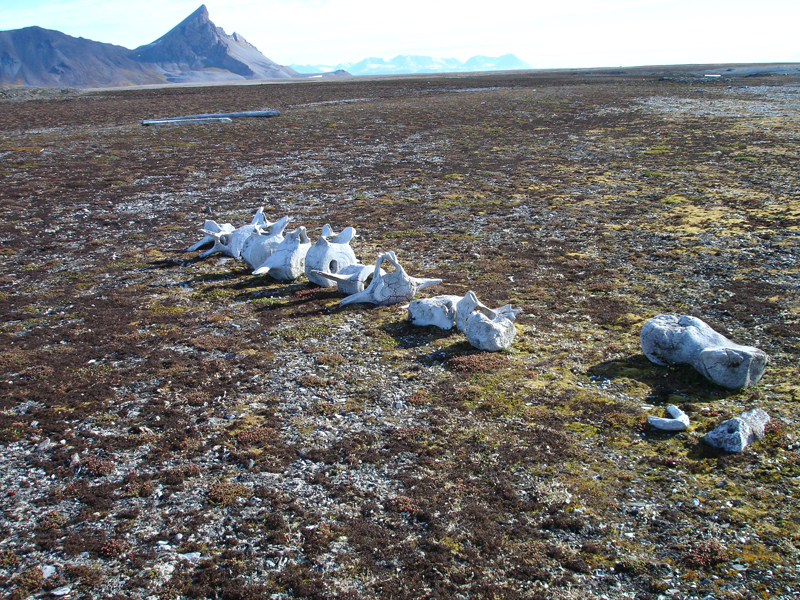Svalbard's vegetationBy Øystein Overrein, Lennart NilsenAt a distance, Svalbard appears to be dominated by bare rocks, glaciers, ice and snow. However, for those with an eye for plant life, the land up north gives another impression. As trees and shrubs are absent in Svalbard, the ground vegetation becomes more visible. In summertime, flowering plants, the dense moss tundra in the valleys, and the lush green vegetation under the bird cliffs are astonishing. Forming a transition between the mountains and the sea, the plateaus host important vegetation types. The plateau landscape varies from exposed ridges, plains and leeward sides with late snow melt (so-called snow beds). 
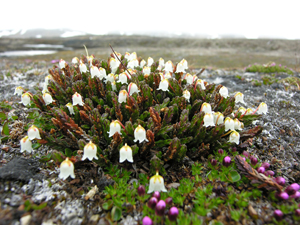

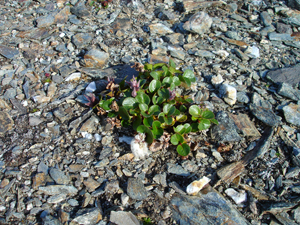
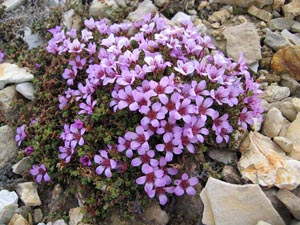
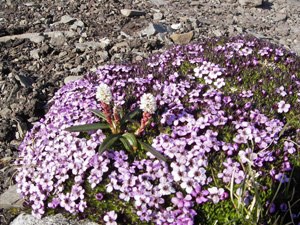
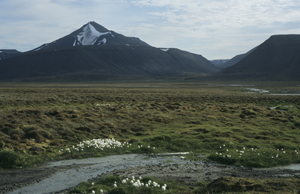
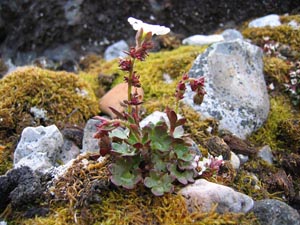
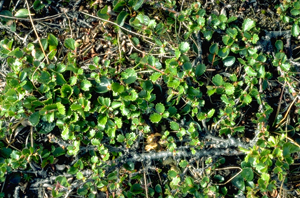
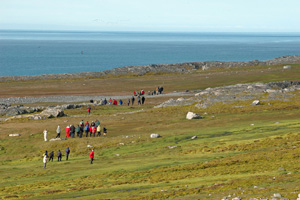
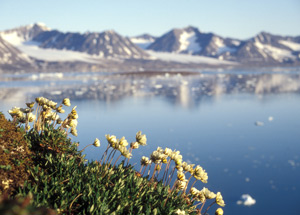


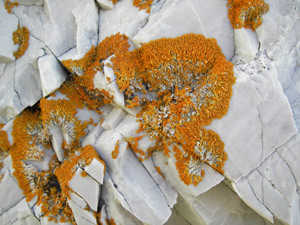
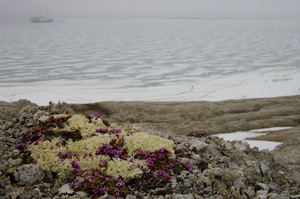

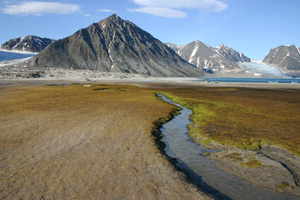
In Svalbard, plant growth and distribution are limited by large temperature fluctuations, a short growth season, nutrient deficiency, wind exposure and soil movement caused by freeze–thaw cycles. The most important factors determining plant distribution are temperature, bedrock type, soil texture and topography. The permafrost thaws 30-150 cm every summer. This makes it possible for plants to grow in the shallow frost-free layer of the soil. This active layer also permits drainage of precipitation and meltwater. Variations in the terrain, drainage, and snow cover thickness and duration contribute to the variation in habitats and vegetation types. The vegetation reflects past and present climateAs early as 10 000-11 000 years BC there was some ice-free areas with scattered vegetation in coastal parts of Svalbard. Between 9000 and 2000 years BC there was a warmer epoch, and denser and more abundant vegetation was established. Thick peat deposits found in Rosenbergdalen on the island of Edgeøya are dated to this epoch. As most of the archipelago was ice-covered during the last ice age it is plausible that most plant species immigrated during the Holocene (i.e. the last 10 000 years). The Svalbard climate differs from other Arctic areas at the same latitude – elsewhere in the circumpolar region plant life this far north is very scarce – but the West Spitsbergen Current brings warm Atlantic water northwards along the west coast of Svalbard and contributes to a warmer climate. Warm air currents from the south and west also bring some heat. At the east coast, cold ocean currents transport cold water from the Arctic Ocean southwards, and this part of Svalbard hosts more typical high-Arctic vegetation. Productivity, vegetation belts and diversityIn Svalbard, the land area with productive vegetation is small. Less than 10 % of the total land area has biological productivity of any importance, and the productivity is often restricted to small areas. A continuous vegetation cover is mainly found in the lowlands near the coast and in the large, ice-free valleys. During the last 120 years the vegetation has been mapped, described and categorized in different ways. According to the bio-climatic criteria currently used to classify regions of the Arctic, Svalbard is divided into the mid-Arctic tundra zone, the northern Arctic tundra zone and the Arctic polar desert. This division into zones reflects the mean temperature for the warmest month: 5-7 °C for the mid-Arctic tundra zone; 3-5 °C for the northern Arctic tundra zone and less than 3 °C for the Arctic polar desert. The zones are recognized by their different plant communities, known as zonal vegetation types, defined by various plant and moss species. The zonal vegetation types for the mid-Arctic, the northern Arctic and the polar desert tundra zones are white Arctic bell-heather communities, Arctic wood-rush communities and Svalbard poppy communities, respectively. A of 2015, about 178 vascular plants, 380-390 moss species, 708 lichen species and >750 species of fungi have been documented in Svalbard. Seven species of vascular plants have been introduced by people. Their establishment appears to be permanent, but these introduced species are confined to areas with human settlements. Examples of these are tufted hair-grass (Deschampsia cespitosa), northern meadow-grass (Poa pratensis ssp. alpigena) and red fescue (Festuca rubra). In addition, 9 introduced species with scarce distribution are known, for example, knotgrass (Polygonum aviculare), sheep's sorrel (Rumex acetosella) and sea mayweed (Tripleurospermum maritimum). In total, 68 Svalbard species do not grow on the Norwegian mainland, but floristically link Svalbard to the Russian and Greenland Arctic. Three species are endemic to Svalbard – i.e., they grow only in Svalbard. These are Svalbard quinquefoil (Potentilla × insularis), Svalbard saxifrage (Saxifraga svalbardensis) and Svalbard saltmarsh grass (Puccinellia svalbardensis). Biological diversity in Svalbard is low compared to the mainland, consistent with the general rule of thumb that biological diversity decreases with increasing latitude, that is, with greater distance from the equator. Many common Scandinavian alpine plants occur in Svalbard, in addition to species that are rare or absent on the mainland. Examples of the latter are spiked snow-grass (Phippsia algida), Svalbard poppy (Papaver dahlianum), tundra chickweed (Stellaria longipes) and sulphur-coloured buttercup (Ranunculus sulphureus). They are all rare in Scandinavia, but common in Svalbard. For other species the reverse is true: they are rare in Svalbard but common on the mainland. For example, alpine rock-cress (Arabis alpina), polar bilberry (Vaccinium uliginosum), cloudberry (Rubus chamaemorus), mountain crowberry (Empetrum nigrum ssp. hermaphroditum) and dwarf birch (Betula nana) are rare in Svalbard. In Svalbard, the equivalent to the mainland shrub vegetation consisting of birch and willow is low-growing vegetation reaching a maximum height of 25 - 30 cm in favourable places. The only Svalbard shrub reaching a considerable height is dwarf birch. It is confined to a few sheltered localities in the Isfjorden area. The two small shrub species, polar willow (Salix polaris) and net-leaved willow (Salix reticulata), are common, but only reach a height of 2-5 cm. Other important environmental factors and plant adaptationsThere are two main groups of bedrock in the Svalbard archipelago. One is of granitic origin (eruptive and metamorphic) with minerals containing much silica. Granitic bedrocks give an acidic (low pH) soil type. The other bedrock type is of sedimentary origin, and often contains calcium, which supports nutrient-rich soil types with a higher pH. The species composition and proportion of vegetation cover are influenced by the pH in the soil, and some species prefer alkaline (high pH) soil types, for instance, mountain avens (white dryad, Dryas octopetala), alpine meadow-grass (Poa alpina) and yellow mountain saxifrage (Saxifraga aiziodes). Other species are most common in areas with acidic soil, such as white Arctic bell-heather (Cassiope tetragona), polar fir clubmoss (Huperzia arctica), northern wood-rush (Luzula confusa) and tundra chickweed. Many species of Svalbard plants feature ecological and/or physiological adaptations that enable them to survive and reproduce in harsh and changing conditions. Tussocks and mat-forming growth forms, hairs, umbrella-shaped flowers, elastic roots, clonal dispersal (by which the plant produces stolons or rhizomes from which genetically identical new plants develop) and nodes are commonly observed and are adaptations to an Arctic life. Most species are also perennial. This is because Arctic plants grow very slowly, and one season is often not sufficient to accumulate resourses for flowering and seed production. The few annual species in Svalbard are very small, for instance, Iceland purslane (Koenigia islandica), mountain eyebright (Euphrasia wettsteinii) and diminutive gentian (Comastoma tenellum). Important landscape forms and vegetation unitsRidges with a thin snow cover become free of snow early in spring, exposing plants to severe stress due to temperature fluctuations, strong light, wind exposure and dry weather. However, the advantage is a relatively long growing season. The ridges host one of the most beautiful and interesting plant associations in Svalbard – the mountain avens heaths. In early June, species like mountain avens, purple saxifrage (Saxifraga oppositifolia) and various species of whitlow-grass (Draba spp.) can initiate growth. Habitats with a thicker snow cover (snow beds), become snow-free much later and therefore have a shorter growth season. In places where the snow cover persists longest, the vegetation does not become snow-free until mid-July, and the plants only have a few weeks to grow, flower and produce seeds. This is the habitat for minute species such as polar willow, alpine bistort (Bistorta vivipara), pygmy buttercup (Ranunculus pygmaeus) and outspread snow-grass (Phippsia concinna). The short growth season leads to a high rate of inbreeding, self-fertilization and clonality. The plant associations of the large valleys in central parts of Spitsbergen, which have a relatively long growth season, are dominated by bryophytes (mosses and liverworts). Plant associations here are characterized by a moisture gradient ranging from relatively dry moss tundra, to moist mires and wet marshes. Vascular plants common to these areas are polar foxtail (Alopecurus magellanicus), polar cress (cuckooflower, Cardamine pratensis ssp. angustifolia), Arctic cottongrass (Eriophorum scheuchzeri ssp. arcticum), black cottongrass (E. angustifolium ssp. triste), alpine hair-grass (Deschampsia alpina), tundra grass (Dupontia fisheri), Arctic wood-rush (Luzula nivalis), polar horsetail (field horsetail, Equisetum arvense ssp. alpestre), two-flowered rush (Juncus biglumis) and various sedges. Along with the bird cliff vegetation, these habitats are the most important grazing areas for reindeer and geese in Svalbard. The vegetation is lush by the foot of bird cliffs and other breeding places for birds. The moss, grass, and herb vegetation is one of Svalbard’s most diverse and species-rich habitats. The soil richly fertilized by bird dropppings, bird cliff plants can become quite tall. Common species are hawkweed-leaved saxifrage (Saxifraga hieracifolia), tufted saxifrage (S. cespitosa), drooping saxifrage (S. cernua), polar scurvygrass (Cochlearia groenlandica), mountain sorrel (Oxyria digyna) and boreal Jacob's ladder (Polemonium boreale). At the coast, by the lagoons and by the river deltas, a special vegetation type occurs – the salt marsh. The salt marshes vary in species composition along a gradient of increasing sea salt influence. Typical species are Arctic saltmarsh sedge (Carex subspathacea), polar bear sedge (C. ursina), creeping saltmarsh grass (Puccinellia phryganodes ssp. vilfoidea) and snow pearlwort (Sagina nivalis). The species composition gives the area a characteristic red to red-brown colour. At or near beach ridges, the beautiful oysterplant (Mertensia maritima ssp. tenella) grows in association with dense mats of sea sandworth (Honkenya peploides ssp. diffusa). Future scenarios and threatsThe official Norwegian Red List of threatened species lists 50 species occurring in Svalbard, of which five species are found near the hot springs in Bockfjorden in the Nordvest-Spitsbergen National Park. The inner fjord areas of Spitsbergen, especially the inner parts of Kongsfjorden, Isfjorden and Van Mijenfjorden, have a particularly rich flora. More than 75 % of all plant species in Svalbard grow here. Species diversity is closely related to the climate, and when climatic conditions change, plant life is affected. In the Arctic, even small changes in environmental conditions can have large impacts on the vegetation – and consequently on the fauna. Climate models predict a warmer and wetter climate in Svalbard as a consequence of increasing concentration of greenhouse gases in the atmosphere. Currently observed climate change in Svalbard is expected to cause changes in vegetation cover and species composition due to increased establishment of non-native species and altered competition between species. The plausible scenario for the near future is that thermophilous (warm-loving) species, like dwarf birch, Arctic holy grass (Hierochloe alpina ssp. alpina), crowberry and polar bilberry, will expand in distribution. Grazing and trampling are two important ecological factors in reindeer grazing areas. Trampling from both humans and reindeer is detrimental to the vegetation cover partly due to increased erosion. Grazing geese has the same impact on the vegetation. Where some damage is caused in the vegetation cover, wind can increase erosion in dry areas, and in wet areas, a similar type of erosion is caused by the repetitive forces of freezing and thawing of water. Some vegetation types are more vulnerable to human impact than others. Low plant productivity leads to very slow re-growth following damage. Because of the permafrost, areas with continuous vegetation cover are especially vulnerable to damage. Once damaged, the insulating effect of the vegetation cover is reduced and leads to increased summer ground thaw and increased erosion. Vegetation-rich areas such as the moss tundra, mires and marshes are especially vulnerable to disturbance. The same applies to the steep hills below the bird cliffs. This is why tourist groups should always be directed around such areas, to avoid causing damage to the vegetation. Our recommendation is that groups of tourists should walk on the dry and least vegetated areas where possible. If you follow these recommendations, the walk may seem tortuous and winding, but will be environmentally friendly. For further reading see www.svalbardflora.net. Updated June 2015 |
The Cruise Handbook is also available in book formHard cover with numerous pictures - 249 pages - NOK 249.00 Norwegian Polar Institute |
 Norsk
Norsk